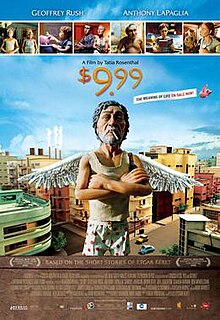 The Life of Brian was the second (1979) feature film made by Monty Python, the British comedy outfit that changed a generation and a country. Almost three decades later Eric Idle, a member of the team's "Flying Circus", transformed the classic spoof of Biblical movie epics into a multi-leveled musical spoof, Not The Messiah (He's a Very Naughty Boy).
The Life of Brian was the second (1979) feature film made by Monty Python, the British comedy outfit that changed a generation and a country. Almost three decades later Eric Idle, a member of the team's "Flying Circus", transformed the classic spoof of Biblical movie epics into a multi-leveled musical spoof, Not The Messiah (He's a Very Naughty Boy).
Idle had already gained new fame and fortune for Spamalot, his musical-comedy adaptation of MP's Holy Grail, another classic movie spoof (sending up the Arthurian legend via many now-immortal sillinesses). For both ventures, long-time behind-the-scenes associate John Du Prez was his co-writer.
NTM premiered as a concert performance at a Toronto festival in 2007. Two years later, its UK premiere was staged at the Royal Albert Hall as a one-night-only celebration of MP's 40th anniversary. Appropriately, all but one of the surviving MP team joined the lavish production, with Michael Palin, Terry Jones and Terry Gilliam donning costumes and reprising comic statements happily cheered and echoed by the Hall's nostalgic Proms-like audience. [John Cleese was on another of his alimony-funding global tours.]
Other old colleagues (such as Carol Cleveland) joined them for a mock Messiah oratorio that should become, at the very least, an annual event at the Hall. It has enough tuneful pastiches and comic set-pieces to become a fully-staged production in the West End, following in Spamalot's successful clip-clopping footsteps. Its Broadway transfer is slightly less likely, as it would continue to anger sensitive Christian souls.
Jewish feelings might be offended too (naturally, in New York) by the outrageously funny tale of Mandy Cohen's impregnation by a Roman centurion and birth of Brian ("a good Jewish boy") who joins a Judean political sect, has an affair with fellow-member Judith ("He's a very naughty boy") and ends up crucified.
Four operatic soloists in formal attire stand front-stage to act/sing the leading roles, alongside "baritonish" Idle himself and his guest stars (including a pipe band, a trio of fake sheep and Idle's harmonica-blasting imitation of Bob Dylan). Told mainly through its songs' lyrics, the fast-paced comedy employs almost every musical genre known to man and Andrew Lloyd Webber, as well as Handel. In between, Idle and Du Prez recall the glories of Rodgers and Hammerstein, Les Miserables, etc and acknowledge their audiences' memories of When Harry Met Sally, McArthur Park, etc and, most emphatically, of course, The Life of Brian.
Viewers will inevitably love some pastiches more than others. The Amourdeus will become a classic item, and my personal favourite is What did the Romans ever do for us? Returning to its original setting (from its Spamalot borrowing) is Look on the bright side of life, and there's a grand finale of audience-delighting irrelevance when Michael Palin, more guest stars and the BBC Symphony Orchestra and its massed choirs perform another MP classic, the Lumberjack Song.
As a DVD entertainment, the production is well-directed, with close-ups, fast edits and panning shots matching the varying beat, moods and lyrics effectively and unobtrusively. The show warrants the high rating, and the hopes that it will make a transfer to the West End.
 Ryan, which won the short animation Oscar in 2005, belongs to a very specialised genre: live action with animation. Not cutely, as in Who Framed Roger Rabbit?, but astonishingly, grotesquely, and very fittingly for a documentary study of a drug-ravaged master cartoonist of the 1970s, Ryan Larkin.
Ryan, which won the short animation Oscar in 2005, belongs to a very specialised genre: live action with animation. Not cutely, as in Who Framed Roger Rabbit?, but astonishingly, grotesquely, and very fittingly for a documentary study of a drug-ravaged master cartoonist of the 1970s, Ryan Larkin.



















